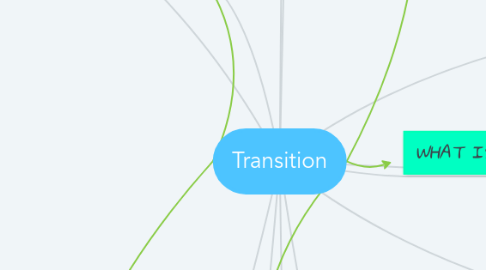
1. Participants
1.1. Student
1.1.1. Communicates preferences, interest, strengths, areas of need, types of support. IEP development and implementation.
1.2. Parent/Guardian
1.2.1. Support the student.
1.2.2. Helps provide information on what they see the students strengths, needs, interests, type of support needed and how to achieve the outcomes they desire.
1.2.3. Participates in developing and implementing the IEP.
1.2.4. Helps make referrals to adult service agencies and training programs.
1.2.5. Helps the student practice and learn adult roles and responsibilities.
1.3. Special education teacher
1.3.1. Provides information about the student's strengths, needs, achievements, and progress on their goals based on the IEP.
1.3.2. Assists the student in identifying postsecondary goals.
1.3.3. Prepares student and family for their leadership roles in the transition process.
1.3.4. Suggest courses of study and educational experiences.
1.3.5. Identifies the needed personal from school, related services, and community agencies.
1.3.6. Provides input and incorporates the IEP services and supports.
1.3.7. Coordinates all people, agencies, services, or programs needed for the student.
1.3.8. Monitors student progress.
1.4. LEA representative
1.4.1. Supports special and general education staff in the IEP and transition process.
1.4.2. Provides information about programs in the school system and community that students can get involved with.
1.4.3. Allocates necessary resources, including technology, accommodations, and supports.
1.5. General education teacher
1.5.1. Assist the student in identifying postsecondary goals.
1.5.2. Assists in planning courses of study in general education curriculum. What modifications, adaptations, and supports being used or that will need to be used.
1.5.3. Identifies and provides positive behavior strategies and interventions.
1.5.4. Monitors student progress.
1.6. Others: Vocational Rehabiliation, Mental Health, Social Security, Employers, Postsecondary educator, and Human Services.
1.6.1. Provide information about services and eligibility criteria.
1.6.2. Assist in identification of community and adult services and in the application process for services.
1.6.3. Alert families and school to potential waiting lists for services.
1.6.4. Provide services. (Functional vocational evaluation, technology and accommodations, counseling, independent living) to student during school, as appropriate.
2. Writing an IEP
2.1. Transition piece of the IEP must be included when the student turns 16 years of age.
2.2. IEP meeting must include representatives of the public agency providing and supervising the transition activities.
2.3. The student must be involved with the transition section of the IEP.
2.3.1. If the student does not have a need in a transtion area, the IEP team must state that and why.
2.4. Beginning point begins with what the individual students needs. These come in three mandated areas.
2.4.1. 1) instruction
2.4.1.1. Assessments, observations, testing and how teachers accommodate or modify material for student must be looked at.
2.4.2. 2) Community experiences
2.4.3. 3) Employment and other post-school living objectives
2.5. The IEP must be updated annually. Or more often when needed.
2.6. If student is not making progress towards the goals, the team must meet and revise sections of the IEP.
2.6.1. School must report to parents on the progress of their child.
2.6.1.1. Progress reports can help determine if revision is needed or not.
3. WHO ARE
4. LEGAL REQUIREMENTS IN TRANSITION WHEN
5. Students, particularly special education students, who are moving from the secondary school to self-reliance, self-advocacy, and independence which is called adult life.
5.1. Teaching them life skills that will assist them in college or their job.
6. Helping students with Individualized Education Plans (IEP) to figure out what they want to do after high school.
6.1. Attending a two-year college or four-year college.
6.2. Joining the military.
6.3. Finding a job right after high school.
7. Helping middle school students who have an IEP figure out what classes they may want to take in high school.
7.1. What classes might be of interest to them.
7.2. If they know what job they want to have after high school or college, helping them determine what classes in high school will prepare them for that.
8. Planning
8.1. High School Units/Graduation
8.2. Graduation date
8.3. Post-graduation study focus
8.4. Credits completed
8.5. Credits remaining
8.6. Transcript grade point average
8.7. Transfer of Rights for students 18 years of age
8.8. Student and parent signatures required if student will be 18 years old prior to the next annual IEP
8.9. Summary Section of post-graduation study focus and current levels of academic performance in transitional area
8.9.1. Summary Section contains a narrative on the students' interest, aptitude and achievements.
9. IDEA
9.1. In 2004, IDEA required that at least one year before the students legally become and adult, they must be aware of their upcoming roles and responsibility.
9.1.1. Age 14 or 16.
9.1.1.1. Starts at age 14 and must be implemented by age 16.
9.2. Students must be made aware of upcoming meetings involving them.
9.2.1. They assume legal control over educational placement, educational records, eligibility, evaluations and programming, and any medication or due process needed to resolve disputes.
9.2.2. Being invited to their IEP meeting and making suggestions or comments.
9.3. Adult services agencies must be contacted and involved in developing transition goals and plans.
9.3.1. Services they fund must be delineated in the plan.
9.4. IEP Team must make sure to visit with service agencies, obtain relevant eligibility information and identify strategies to ensure active participation and meaningful involvement of students in the transition planning process.
9.5. Students IEP must have an education/training section that discusses what the student will do after graduating high school.
9.5.1. The IEP also needs to discuss what the student would like to do in regards to employment after graduation of high school or college.
9.5.2. Students will have an independent living section of the IEP that discusses what they will do after graduating high school or their desired college and how they will go about obtaining their living situation.
9.5.2.1. Appropriate measurable postsecondary goals based on these transitions.

